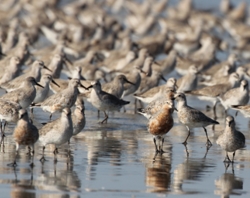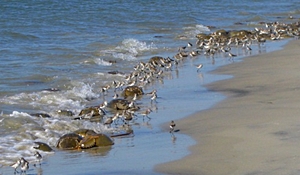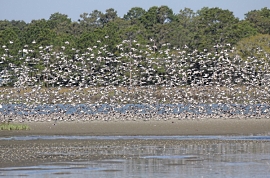Coastal Birds in South Carolina
Red Knot & Other Long-Distance Migrants

The Red Knot is a fairly large sandpiper with a medium sized bill and rufus colored plumage in the breeding season. Red Knots breed in the tundra of the high Arctic. A large portion of the species travel thousands of miles to spend the winter in the southern part of South America including Brazil and Tierra del Fuego, while another portion of the species spends the winter on the southeastern coast of the U.S. including South Carolina, Georgia and Florida. Overall, the number of Red Knots has declined nearly 85% over the last 15 years from an estimated population of over 150,000 to the current number of approximately 25,000 (Niles et al. 2008, Dey and Niles 2011). Because of this drastic population decline, the Red Knot has been listed as "Federally Threatened" under the Endangered Species Act. South Carolina provides habitat for both migrating and wintering Red Knots and other long distance migrants such as Whimbrels and Rudy Turnstones.

Red Knot flocks roost on inlets of barrier beaches and islands in South Carolina and feed on coquina (Donax sp.) clams in the fall and winter. In the spring, Red Knots and other shorebirds feed on Horseshoe Crab (Limulus polyphemus) eggs when crabs come onshore to spawn. The link between Horseshoe Crabs and shorebirds is an interesting one. Horseshoe Crabs surface to spawn in great numbers every spring, drawn ashore by full and new moons and when tides are highest. The female Horseshoe Crabs lay thousands of eggs in the sand, and shorebirds like the Red Knot spend time on spawning beaches and feed on the crabs' nutrient-rich eggs to fatten up before their migration to the breeding grounds in the Arctic. Additional information on Horseshoe Crabs can be found here.
- Horseshoe Crab spawning season a boon for shorebirds (SCDNR News Release, June 16, 2014)
- Species Information: Horseshoe Crab (SCDNR, Marine Resources Research Institute)
- Species Information: Horseshoe Crabs (SCDNR, Crustacean Research Section)
SCDNR has conducted research on Red Knots including capturing and banding birds with uniquely engraved markers, surveying migrating and wintering flocks, resighting banded birds, identifying forage items, and fitting birds with geolocator devices. Geolocators are small, electronic devices that measure and record light levels to determine global location. Geolocators have been used to study bird migration routes, and identify staging areas and nesting locations.

Despite the large flocks sometimes present on our beaches, shorebirds are declining. Because large numbers of shorebirds often concentrate in a single location at a stop-over site, they are vulnerable to disturbance. Joggers, beach combers, bicyclists, and off leash dogs can flush feeding and roosting birds causing them to expend energy in flight. This may cause them not to build enough fat reserves for their migration journey.
Literature Cited
Dey, A. D., et al. "Update to the status of the Red Knot Calidris canutus in the Western Hemisphere, April 2011. Draft update to Status of the Red Knot (Calidris canutus rufa) in the Western Hemisphere." Studies in Avian Biology 36 (2011).
